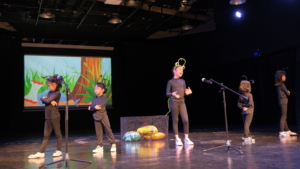How To Teach A Language In A Fun Way
Learning a new language can be an exhilarating journey for children, especially when the process is engaging and enjoyable. Teaching a language in a fun way ensures that kids not only grasp the language effectively but also develop a love for learning. Here’s an extensive guide on how to make language learning an enjoyable and enriching experience for kids.
Create an Immersive Language Environment
An immersive language environment is one of the most effective strategies for teaching a language in a fun way. This approach involves surrounding children with the language in their daily lives, similar to how they learn their native tongue. Use the target language in everyday conversations, label household items, and incorporate the language into daily routines. Watching cartoons, listening to songs, and reading storybooks in the target language can also significantly enhance immersion, making the language a natural part of the child’s world.
Incorporate Play-Based Learning
Children naturally learn through play, making it an ideal method for teaching a new language. Games like language-specific Scrabble, Pictionary, and charades can make learning new words and phrases exciting and memorable. These games not only teach vocabulary but also encourage children to use the language actively. The key is to choose games that are age-appropriate and aligned with the language skills you aim to develop, ensuring that the learning process remains enjoyable and effective.
Use Music and Songs

Music is a powerful tool for language learning, as songs are catchy, repetitive, and enjoyable. Choose songs with simple lyrics and engaging tunes to help children remember vocabulary and grammar structures. Singing along to these songs can improve pronunciation and rhythm in the target language. Nursery rhymes, action songs, and educational songs can all be effective, providing a fun and rhythmic way to learn a new language.
Interactive Storytelling
Storytelling captivates children’s imagination and can be a highly effective method for teaching a language. Interactive storytelling, where children participate in the narrative, enhances their listening and speaking skills. Use props, puppets, and expressive voices to bring stories to life, making the experience engaging and memorable. Encourage children to predict the story’s progression or retell it in their own words, which helps reinforce their language skills in a fun and interactive way.
Role-Playing and Drama
Role-playing and drama activities offer dynamic ways to teach a language. Acting out scenarios helps children practice speaking in context, enhancing their comprehension and usage of the language. Create simple scripts based on everyday situations like going to the market, visiting the doctor, or having a picnic. Encourage children to take on different roles and express themselves in the target language. This method not only makes learning fun but also helps children build confidence in their language abilities.
Leverage Technology and Apps
In today’s digital age, technology can significantly aid language learning. Educational apps and online games designed for language learning can make the process interactive and enjoyable. Apps like Duolingo, Babbel, and Lingokids offer engaging activities that teach vocabulary, grammar, and pronunciation. These tools keep children motivated and interested in learning, leading to better retention and application of language skills. However, it’s essential to balance screen time with other interactive and physical activities for a holistic learning approach.
Incorporate Arts and Crafts
Arts and crafts activities can be seamlessly integrated into language lessons to make learning more engaging. Creating a scrapbook with labeled pictures, drawing, and coloring activities based on language instructions can all be effective. These hands-on activities allow children to express their creativity while practicing their language skills. By following English instructions during craft projects, children can learn new vocabulary and concepts in a tangible and enjoyable way.
Use Rewards and Positive Reinforcement
Positive reinforcement is a powerful motivator for children. Use a reward system to celebrate their achievements in language learning. Rewards can be in the form of stickers, certificates, or extra playtime. The goal is to create a positive learning environment where children feel encouraged and excited to learn the language. This approach helps build a sense of accomplishment and keeps children motivated to continue learning.
Conduct Group Activities and Discussions
Group activities and discussions can foster a sense of community and make language learning more enjoyable. Group storytelling, debates, or project-based learning encourages children to communicate and collaborate in the target language. These activities also teach important social skills such as listening, turn-taking, and respecting others’ opinions. Engaging with peers in a fun and supportive setting helps children feel more comfortable using the language.
Case Study: The Impact of Play-Based Learning in Singapore
A study conducted by the National Institute of Education in Singapore highlighted the effectiveness of play-based learning in early childhood education. The research found that children who engaged in play-based learning showed significant improvements in language skills, creativity, and social interactions. The study emphasized the importance of incorporating play in educational settings to enhance learning outcomes.
Source: National Institute of Education, Singapore
Case Study: Technology-Enhanced Language Learning
Another research by the Singapore University of Technology and Design explored the impact of technology on language learning. The study revealed that interactive apps and online games significantly improved children’s vocabulary and grammar skills. The researchers noted that the engaging nature of technology kept children motivated and interested in learning, leading to better retention and application of language skills.
Source: Singapore University of Technology and Design
Encourage Reading and Library Visits
Reading is fundamental to language learning. Encourage children to read books that interest them, whether it’s fairy tales, adventure stories, or comics. Regular visits to the library can make reading an exciting activity. Libraries often have reading programs and storytelling sessions that can further stimulate a child’s interest in books and the target language. Exposure to diverse literature helps children build vocabulary, understand different sentence structures, and develop a deeper appreciation for the language.
Promote Peer Learning and Interaction
Peer learning can be a powerful motivator for children. Arrange playdates or study groups where kids can practice the target language together. Peer interaction allows children to learn from each other, practice conversational skills, and build friendships in a supportive environment. It’s a natural and effective way for kids to improve their language abilities. Engaging in conversations with peers helps children apply their language skills in real-life situations, making learning more meaningful and enjoyable.
Foster a Positive Learning Attitude
Creating a positive and supportive learning environment is crucial for language acquisition. Celebrate every small success and encourage children to keep trying, even if they make mistakes. A positive attitude towards learning can significantly influence a child’s motivation and enthusiasm. Remember, the goal is to make learning a new language a fun and rewarding experience. Encouragement and praise can boost a child’s confidence and willingness to participate in language activities.
Engage in Outdoor Learning
Outdoor activities can provide a refreshing break from traditional classroom settings while offering unique learning opportunities. Activities like nature walks, scavenger hunts, or visits to the zoo can be conducted in the target language. Describe the surroundings, name the objects, and ask questions in the target language. This real-world practice helps children apply their language skills in different contexts, enhancing their understanding and retention of the language. Outdoor learning combines physical activity with language practice, making it an enjoyable and effective approach.
Teaching a language in a fun way is all about creativity, engagement, and encouragement. By incorporating these strategies, parents and educators can create a stimulating learning environment that fosters a love for language learning. For more information on enriching children’s language learning experiences, visit the Helen O’Grady website.
Click on the link to find out more about Helen O’Grady. Chat with our representatives today!
About Helen O’Grady
Kids Public Speaking


